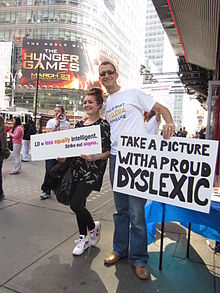
Back إعاقة غير مرئية Arabic অদৃশ্য প্রতিবন্ধকতা Bengali/Bangla Usynligt handicap Danish Αόρατη αναπηρία Greek Handicap invisible French נכות בלתי נראית HE Niewidoczna niepełnosprawność Polish Ubumuga butagaragara Kinyarwanda Невидљива инвалидност Serbian Osynligt handikapp Swedish
The examples and perspective in this article deal primarily with the United States and do not represent a worldwide view of the subject. (June 2011) |

Invisible disabilities, also known as hidden disabilities or non-visible disabilities (NVDs), are disabilities that are not immediately apparent. They are typically chronic illnesses and conditions that significantly impair normal activities of daily living.
For example, some people with visual or auditory disabilities who do not wear glasses or hearing aids, or who use discreet hearing aids, may not be obviously disabled. Some people who have vision loss may wear contact lenses.
Invisible disabilities can also include issues with mobility, such as a sitting disability like chronic back pain, joint problems, or chronic pain. People affected may not use mobility aids on some days, or at all, because severity of pain or level of mobility may change from day to day. Most people with repetitive strain injury move in a typical and inconspicuous way, and are even encouraged by the medical community to be as active as possible, including playing sports; yet those people can have dramatic limitations in how much they can type, write or how long they can hold a phone or other objects in their hands.
Mental disabilities or illnesses, such as ADHD, Depression, Anxiety, Addiction, Dyslexia, Autism, or Schizophrenia, are also classified as invisible disabilities because they are usually not detected immediately by looking or talking to a person.
People with disabilities may experience solely visible or invisible ailments, while others experience both visible and invisible impairments. This includes impairments that may only be visible due to specific circumstances.[1]
96% of people with chronic illnesses have an invisible disability. It is estimated that 1 in 10 Americans live with an invisible disability.[2] This number is likely higher worldwide, as 80% of all people with disabilities live in developing countries.[3]
- ^ Kelly, Rebecca; Mutebi, Natasha (12 January 2023). "Invisible Disabilities in Education and Employment". UK Parliament Post.
- ^ World, Disabled (1 January 2014). "Invisible Disabilities: List and General Information". Disabled World. Retrieved 2 July 2023.
- ^ "Factsheet on Persons with Disabilities | United Nations Enable". www.un.org. Retrieved 2 July 2023.
© MMXXIII Rich X Search. We shall prevail. All rights reserved. Rich X Search